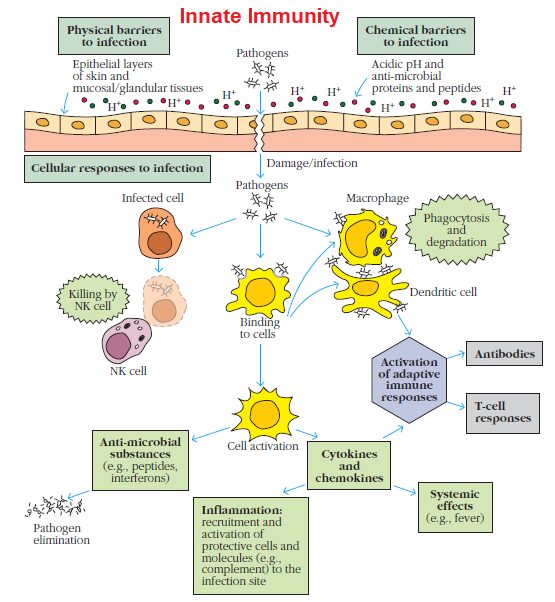Innate Immunity
Vertebrates are protected by both innate immunity and adaptive immunity. In contrast to adaptive immune responses, which take days to arise following exposure to antigens, innate immunity consists of the defenses against infection that are ready for immediate action when a host is attacked by a pathogen (viruses, bacteria, fungi, or parasites). The innate immune system includes anatomical barriers against infection—both physical and chemical—as well as cellular responses.

The main physical barriers the body’s first line of defense are the epithelial layers of the skin and of the mucosal and glandular tissue surfaces connected to the body’s openings; these epithelial barriers prevent infection by blocking pathogens from entering the body.
Chemical barriers at these surfaces include specialized soluble substances that possess antimicrobial activity as well as acid pH. Pathogens that breach the physical and chemical barriers due to damage to or direct infection of the epithelial cell layer can survive in the extracellular spaces (some bacteria, fungi, and parasites) or they can infect cells (viruses and some bacteria and parasites), eventually replicating and possibly spreading to other parts of the body.
The cellular innate immune responses to invasion by an infectious agent that overcomes the initial epithelial barriers are rapid, typically beginning within minutes of invasion. These responses are triggered by cell surface or intracellular receptors that recognize conserved molecular components of pathogens.
Some white blood cell types (macrophages and neutrophils) are activated to rapidly engulf and destroy extracellular microbes through the process of phagocytosis. Other receptors induce the production of proteins and other substances that have a variety of beneficial effects, including direct antimicrobial activity and the recruitment of fluid, cells, and molecules to sites of infection.

This influx causes swelling and other physiological changes that collectively are called inflammation. Such local innate and inflammatory responses usually are beneficial for eliminating pathogens and damaged or dead cells and promoting healing. For example, increased levels of antimicrobial substances and phagocytic cells help to eliminate the pathogens, and dendritic cells take up pathogens for presentation to lymphocytes, activating adaptive immune responses.
Natural killer cells recruited to the site can recognize and kill virus-infected, altered, or stressed cells. However, in some situations these innate and inflammatory responses can be harmful, leading to local or systemic consequences that can cause tissue damage and occasionally death.
To prevent these potentially harmful responses, regulatory mechanisms have evolved that usually limit such adverse effects. Despite the multiple layers of the innate immune system, some pathogens may evade the innate defenses. On call in vertebrates is the adaptive immune system, which counters infection with a specific tailor-made response to the attacking pathogen.
Difference between Innate and adaptive immunity
| Attribute | Innate immunity | Adaptive immunity |
| Response time | Minutes/hours | Days |
| Specificity | Specific for molecules and molecular patterns associated with pathogens and molecules produced by dead/damaged cells | Highly specific; discriminates between even minor differences in molecular structure of microbial or nonmicrobial molecules |
| Diversity | A limited number of conserved, germ line encoded receptors | Highly diverse; a very large number of receptors arising from genetic recombination of receptor genes in each individual |
| Memory responses | Some (observed in invertebrate innate responses and mouse/human NK cells) | Persistent memory, with faster response of greater magnitude on subsequent exposure |
| Self/nonself discrimination | Perfect; no microbe-specific self/nonself patterns in host | Very good; occasional failures of discrimination result in autoimmune disease |
| discrimination result in autoimmune disease | Many antimicrobial peptides, proteins, and other mediators | Antibodies and cytokines |
| Major cell types | Phagocytes (monocytes, macrophages, neutrophils), natural killer (NK) cells, other leukocytes, epithelial and endothelial cells | T cells, B cells, antigen-presenting cells |
This attack occurs in the form of B and T lymphocytes, which generate antibodies, and effector T cells that specifically recognize and neutralize or eliminate the invaders. While innate immunity is the most ancient form of defense, found in all multicellular plants and animals, adaptive immunity is a much more recent evolutionary invention, having arisen in vertebrates.
In these animals, adaptive immunity complements a well-developed system of innate immune mechanisms that share important features with those of our invertebrate ancestors. A large and growing body of research has revealed that as innate and adaptive immunity have co-evolved in vertebrates, a high degree of interaction and interdependence has arisen between the two systems.
Recognition by the innate immune system not only kicks off the adaptive immune response but also helps to ensure that the type of adaptive response generated will be effective for the invading pathogen.
Reference and Sources
- https://opentextbc.ca/biology/chapter/23-2-adaptive-immune-response/
- http://modaresanesharif.ac.ir/sanjeshDl.php?x=arshad95/questions/1505.pdf
- https://saednews.com/public/storage/files/2017/11/28/2030.pdf
- https://www.flashcardmachine.com/kuby-immunologych5.html
- http://mupgdepartmentzb.com/wp-content/uploads/2020/03/Topic-3-Innate-Immunity.pdf
- https://www.researchgate.net/publication/41165733_The_immunology_of_fibrosis_Innate_and_adaptive_responses
- https://www.hindawi.com/journals/mi/2015/794143/
- https://www.researchgate.net/publication/51740613_Microbiota_and_Autoimmune_Disease_The_Hosted_Self
- https://owlcation.com/stem/Giardia-in-the-Intestine-An-Interesting-Parasite
Also Read:
- Overview of an antimicrobial agents
- Water as a Microbial Habitat
- Tissue Transplantation Rejection
- Nosocomial Infection: Introduction, Source, Control and prevention
- Granulocytes: Introduction, Types, Functions and Roles
- Downstream processing and its steps
- Cider: Production, Extraction, Fermentation and Maturation
- Xanthan gum: Introduction, Structure, applications and Production
- Transcription in prokaryotes: Initiation, Elongation and Termination
- AIDS: Acquired Immune Deficiency Syndrome
